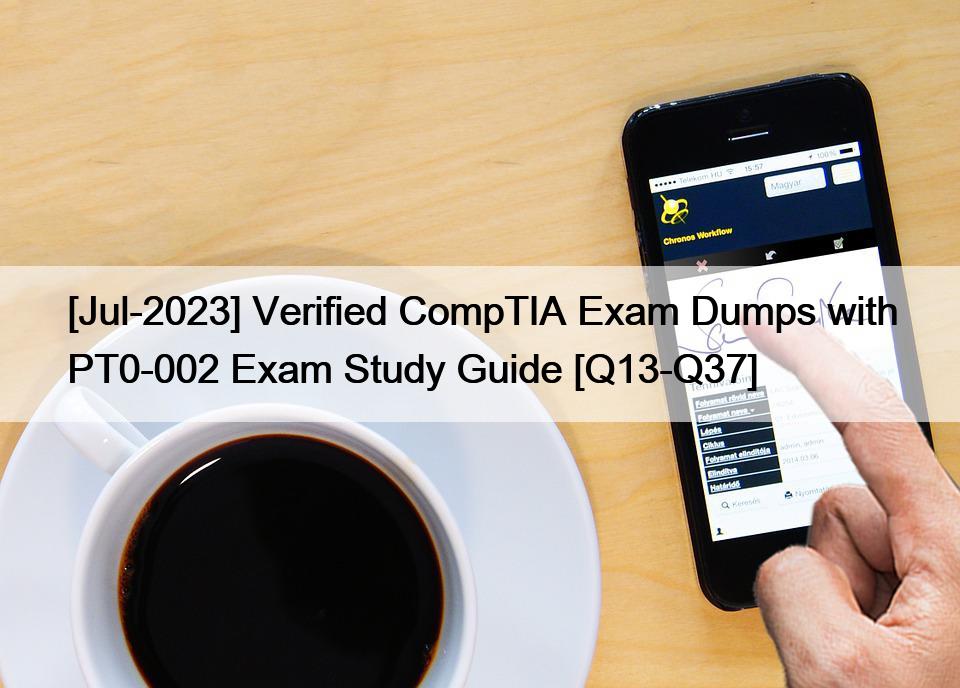[2024] Easy To Download PT0-002 Actual Exam Dumps Resources [Q26-Q47]
[2024] Easy To Download PT0-002 Actual Exam Dumps Resources
Uplift Your PT0-002 Exam Marks With The Help of PT0-002 Dumps
CompTIA PT0-002 Certification Exam is a certification program that provides the necessary knowledge and skills to professionals looking to advance their career in penetration testing. CompTIA PenTest+ Certification certification is designed for professionals who want to claim a mastery over the concepts and techniques of penetration testing, security testing, and vulnerability analysis. CompTIA PenTest+ Certification certification is meant for security analysts, vulnerability assessment and management specialists, security consultants, and ethical hackers.
CompTIA PT0-002 (CompTIA PenTest+ Certification) exam is an internationally recognized certification exam for professionals who want to specialize in penetration testing. PT0-002 exam is designed to test an individual’s knowledge and skills in identifying vulnerabilities and conducting penetration testing of computer systems, networks, and applications. The PT0-002 certification exam involves hands-on scenarios where professionals must demonstrate their ability to conduct complex penetration testing tasks.
CompTIA PT0-002 Exam Syllabus Topics:
| Topic | Details |
|---|---|
Planning and Scoping – 15% |
|
| Explain the importance of planning for an engagement. | – Understanding the target audience – Rules of engagement – Communication escalation path – Resources and requirements
– Budget
– Technical constraints
|
| Explain key legal concepts. | – Contracts
– Environmental differences
– Written authorization
|
| Explain the importance of scoping an engagement properly. | – Types of assessment
– Special scoping considerations
– Target selection
– Strategy
– Risk acceptance
|
| Explain the key aspects of compliance-based assessments. | – Compliance-based assessments, limitations and caveats
– Clearly defined objectives based on regulations |
Information Gathering and Vulnerability Identification – 22% |
|
| Given a scenario, conduct information gathering using appropriate techniques. | – Scanning – Enumeration
– Packet crafting
– Eavesdropping
– Decompilation
|
| Given a scenario, perform a vulnerability scan. | – Credentialed vs. non-credentialed – Types of scans
– Container security
– Considerations of vulnerability scanning
|
| Given a scenario, analyze vulnerability scan results. | – Asset categorization – Adjudication
– Prioritization of vulnerabilities
|
| Explain the process of leveraging information to prepare for exploitation. | – Map vulnerabilities to potential exploits – Prioritize activities in preparation for penetration test – Describe common techniques to complete attack
|
| Explain weaknesses related to specialized systems. | – ICS – SCADA – Mobile – IoT – Embedded – Point-of-sale system – Biometrics – Application containers – RTOS |
Attacks and Exploits – 30% |
|
| Compare and contrast social engineering attacks. | – Phishing
– Elicitation
– Interrogation
|
| Given a scenario, exploit network-based vulnerabilities. | – Name resolution exploits
– SMB exploits
– DoS/stress test |
| Given a scenario, exploit wireless and RF-based vulnerabilities. | – Evil twin
– Deauthentication attacks |
| Given a scenario, exploit application-based vulnerabilities. | – Injections
– Authentication
– Authorization
– Cross-site scripting (XSS)
– Cross-site request forgery (CSRF/XSRF)
– File inclusion
– Unsecure code practices
|
| Given a scenario, exploit local host vulnerabilities. | – OS vulnerabilities
– Unsecure service and protocol configurations
– Default account settings
– Physical device security
|
| Summarize physical security attacks related to facilities. | – Piggybacking/tailgating – Fence jumping – Dumpster diving – Lock picking – Lock bypass – Egress sensor – Badge cloning |
| Given a scenario, perform post-exploitation techniques. | – Lateral movement
– Persistence
– Covering your tracks |
Penetration Testing Tools – 17% |
|
| Given a scenario, use Nmap to conduct information gathering exercises. | – SYN scan (-sS) vs. full connect scan (-sT) – Port selection (-p) – Service identification (-sV) – OS fingerprinting (-O) – Disabling ping (-Pn) – Target input file (-iL) – Timing (-T) – Output parameters
|
| Compare and contrast various use cases of tools. | – Use cases
– Tools
|
| Given a scenario, analyze tool output or data related to a penetration test. | – Password cracking – Pass the hash – Setting up a bind shell – Getting a reverse shell – Proxying a connection – Uploading a web shell – Injections |
| Given a scenario, analyze a basic script (limited to Bash, Python, Ruby, and PowerShell). | – Logic
– I/O
– Substitutions
– Error handling |
Reporting and Communication – 16% |
|
| Given a scenario, use report writing and handling best practices. | – Normalization of data – Written report of findings and remediation
– Risk appetite |
| Explain post-report delivery activities. | – Post-engagement cleanup
– Client acceptance |
| Given a scenario, recommend mitigation strategies for discovered vulnerabilities. | – Solutions
– Findings
– Remediation
|
Use CompTIA PT0-002 Dumps To Succeed Instantly in PT0-002 Exam: https://www.premiumvcedump.com/CompTIA/valid-PT0-002-premium-vce-exam-dumps.html

